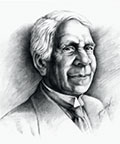David Unaipon (1872–1967)

Writer, public speaker and inventor.
David Unaipon made significant contributions to science and literature and to improvements in the conditions of Aboriginal people. He was prominent in public life as a spokesman for Aboriginal people and was often called upon to participate in royal commissions and inquiries into Aboriginal issues.
Some of Unaipon's inventions include an improved hand tool for shearing sheep, a centrifugal motor, a multi-radial wheel and a mechanical propulsion device; he was unable, however, to get financial backing to develop his ideas. He gained a reputation at the time of being ‘Australia's Leonardo’ for his promotion of scientific ideas.
As an employee of the Aborigines' Friends' Association for many years, he travelled widely and became well known throughout south-eastern Australia. While on his travels, Unaipon lectured on his ideas, preached sermons and spoke about Aboriginal legends and customs. He also spoke of the need for ‘sympathetic co-operation’ between whites and blacks, and for equal rights for both black and white Australians.
1872: A Ngarrindjeri man, Unaipon was born at the Point McLeay Mission, on the Lower Murray in South Australia, on 28 September 1872, the fourth of nine children of the evangelist James Ngunaitponi and his wife Nymbulda, both of whom were Yaraldi speakers.
1879–1885: Unaipon received his initial education at the Point McLeay Mission School.
1885: He left to become a servant to C. B. Young.
1890: Unaipon returned to Point McLeay.
1902: Unaipon married Katherine Carter (nee Sumner), a Tangani woman from The Coorong, in January 1902.
1909: Unaipon patented an improved hand tool for sheep shearing.
1914: As early as 1914, Unaipon anticipated the helicopter, applying the principle of the boomerang. His search for the secret of perpetual motion lasted throughout his life.
1924, 1925, 1929: Unaipon became the first Aboriginal writer to be published. His earliest published works include articles entitled ‘Aboriginals: Their Traditions and Customs’ in the Sydney Daily Telegraph (2 August 1924) and ‘The Story of the Mungingee’ in The Home magazine (February 1925), and a 15-page booklet entitled Native Legends, which was published in 1929. His articles in the Sydney Daily Telegraph were said to have been written in a prose that showed the influence of Milton (he had memorised passages of Milton's poetry), and Bunyan.
1928–1929: He assisted the Bleakley inquiry into Aboriginal welfare.
1930: His writings were included in Myths and Legends of the Australian Aboriginals (London, 1930). Other articles, poetry and legends were published throughout his life. The handwritten manuscript of one of his books on Aboriginal legends, which is reflected in the $50 banknote, survives in the Mitchell Library in Sydney.
1934: Unaipon urged the Commonwealth to assume responsibility for Aboriginal affairs and proposed that an independent board replace South Australia's chief protector of Aboriginal people.
1953: Unaipon was awarded a Coronation Medal.
1967: Unaipon died on 7 February 1967 and was buried in Point McLeay cemetery.
1985: He was posthumously awarded the FAW Patricia Weickhardt Award for Aboriginal writers.
1988: He was also honoured by the establishment of an annual national David Unaipon Award for unpublished Aboriginal and Torres Strait Islander writers and an annual Unaipon lecture in Adelaide.
Further information is available in Notable Australians.